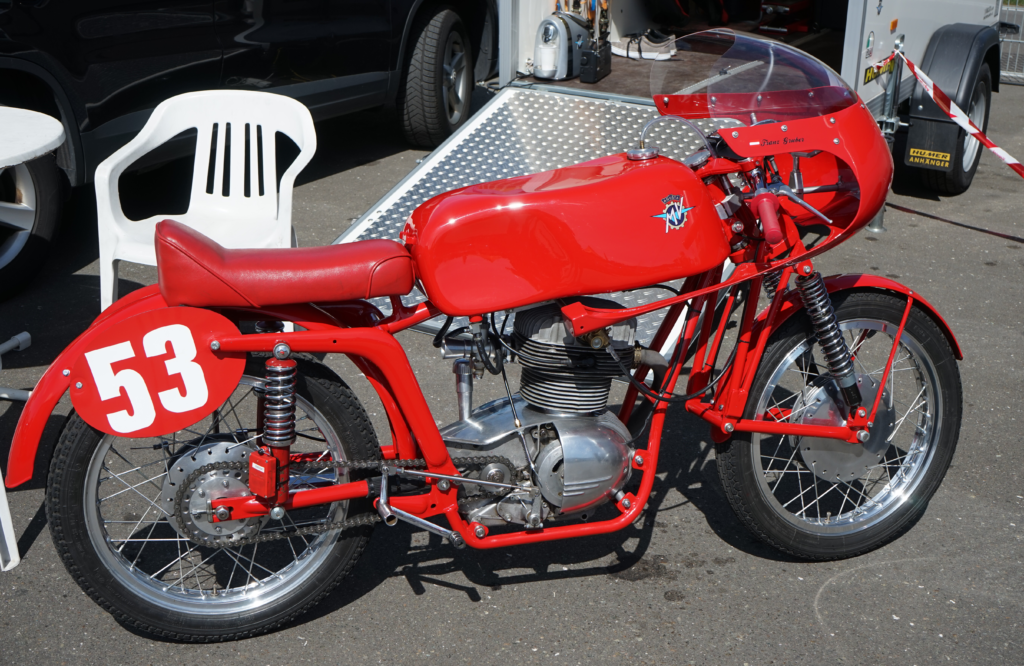
Return to Northern Ireland for the Ulster Grand Prix
Not for the first time there was a race near Belfast in which not even all the points were achieved. The 125cc class was almost traditionally affected by this. For superstar and 500cc defending champion Geoff Duke, after two failures since Spa, the third race since his return was a nightmare. Given the fact that the defense of the title had long since been lost anyway, this could only have had a cosmetic character at best. As is so often the case in Northern Ireland, British pilots dominated the larger two classes, while in the smaller two categories, not for the first time, Italian and another foreign language (from the islanders’ perspective) were spoken at the top of the podium. For the first time since 1953, the checkered flag was used in all four solo classes on the Dundrod Circuit and World Championship points were awarded accordingly in all solo categories. However, compared to the 350s and the premier class, the starting field in the two smaller categories was, as is so often the case, downright ridiculous.

The often experienced tragedy of the 125cc at the Ulster GP
Initially, the category up to 125ccin Ulster only had eight participants. However, only seven pilots took part. Only two of them ultimately crossed the finish line: Carlo Ubiali and Romolo Ferri. Three others had completed a sufficient number of rounds to still be classified. Against this background, reporting on a real race is almost impossible. So let’s leave it at the duel between Ferri on the fully faired 2-cylinder Gilera racer, which produced around 20 hp, with series winner Ubbiali on his single-cylinder MV Agusta (the Mondial and DKW two-stroke engines also had single-cylinder engines). Soon there was even unexpectedly strong competition from behind the Iron Curtain. Based on the technical basis of the pre-war DKW RT 125, the brilliant designer Kaaden from the GDR still had a few arrows in his quiver that would amaze the competition. But back to the race in the smallest category.
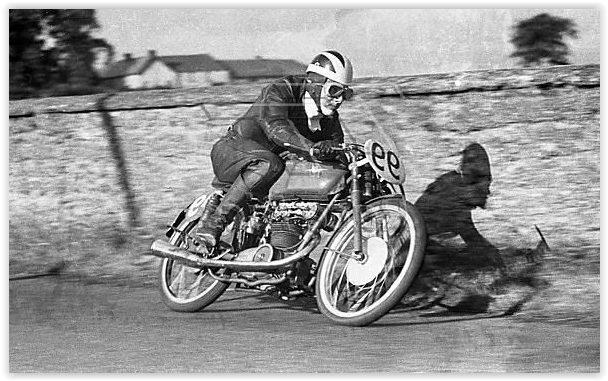
The starting position before the second to last 125cc round of the season
With only six competitors, this season’s dominator rarely had to fight to get his points. But this time it was a similarly strange race to the one he first experienced in Northern Ireland on the former Clady Circuit in 1950, when only he and the future world champion Bruno Ruffo (both on FB-Mondial) saw the checkered flag. Because this was his first Grand Prix victory, the northern Italian never forgot it. He should certainly never lose the Ulster Grand Prix from his memory this time either. Especially because after his triumph in the second world championship up to 125 cc in history, which only lasted three rounds, he never reached the finish line once again. At least this time, after no fewer than five failures in the race near Belfast, it finally worked for a second time.

The Dominator won again and a world record amazed the experts
After it rained on the night from Friday to Saturday, the conditions for this race improved. Only strong westerly winds affected the tiny number of 7 starters only. Although the Swiss Camathias on the private MV (he was particularly successful in the sidecars at that time) didn’t even get away. Initially, in addition to Ubbiali and Ferri, Luigi Taveri also got involved on the second factory MV Agusta, but his teammate Ubbiali was definitely too strong that day. The Swiss had to park his machine in P3 on lap seven due to technical problems and Gilera factory driver Ferri ended up one and a half minutes behind his superior compatriot Ubbiali as the winner. And a world record was set that day by the Englishman Frank Cope, who scored two points in the 125cc race. At 60 years old, he is undoubtedly the oldest rider to enter his name in the motorcycle world championship.

The race up to 250cc also had limited participation
With only 12 riders on the starting grid, this couldn’t be said to be a race worthy of a World Cup. After the start, NSU private pilot Brown surprisingly led ahead of Miller, Taveri and Ubbiali. Three laps later, the two factory drivers from MV with Taveri and Ubbiali were in the lead, followed by Miller and Brown. Little changed until the eleventh of 13 laps, when the Italian suddenly raised his hand. It failed due to a stuck float needle on its carburettor (a very common problem at the time that also often shut down two-stroke engines). This cleared the way for Taveri, who at least saved a very disastrous season with a Grand Prix victory up to 250 cc. With second place, private driver Sammy Miller underlined how strong the NSU Sportmax still was at this time, with whom “HaPe” Müller had won the 250cc title last year as the first pilot not belonging to a factory team. Miller’s gap to winner Taveri with the factory MV Agusta of just 13.6 seconds served as proof of this. Arthur Wheeler on his private Moto-Guzzi was already over three and a half minutes behind in third place. Behind Coleman on another NSU, Maddrick (Guzzi) and the Swiss Büla (NSU) with the last World Cup point.

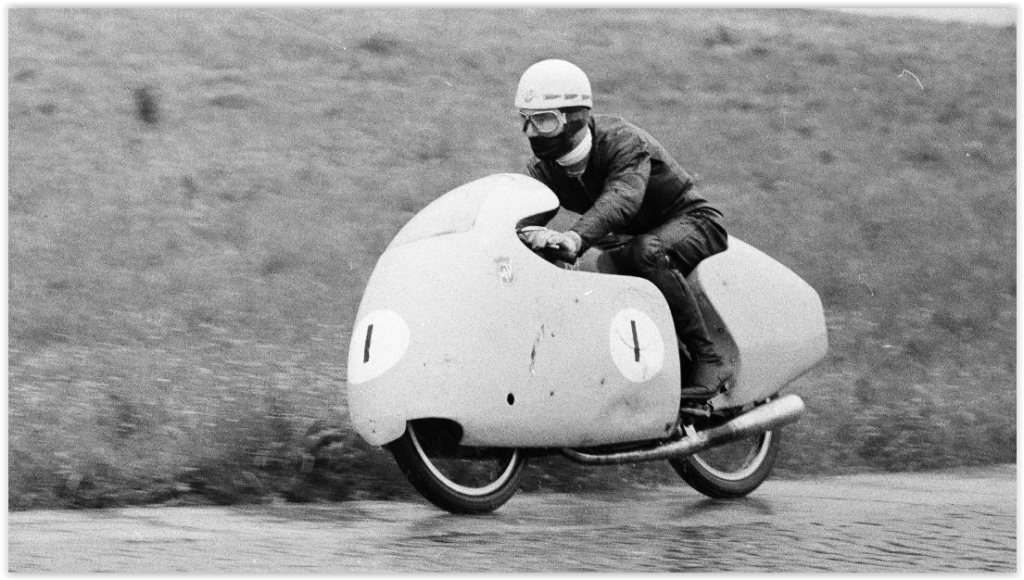
Tragic 350cc race with the title decision
Reigning world champion Bill Lomas traveled to Belfast tied on points with August Hobl (DKW). If he wins here, the Englishman could secure his title defense early. Although DKW decided to travel all the way to the British island with the World Cup in mind, it didn’t pay off for the German manufacturer and its pilots. The favorite had already set the fastest lap in training and Lomas also had three very strong men in the same team with Dale, Kavanagh and Ennett, who had recently been signed by Moto-Guzzi instead of Wheeler, who could support him. On the other hand, DKW had to do without their regular rider Hofmann. After all, “Gustl” Hobl and Cecil Sandford had set the next fastest times in training behind Lomas. After the start, Sandford led ahead of his DKW factory team colleagues Hobl and Hartle. A little later, however, the German was caught by Hartl and Dale and then fell further and further back, but without dropping out. In the second lap, Sandford, the second DKW man, was under pressure and Lomas, of all people, replaced him at the top. Shortly afterwards, the tragedy of the weekend happened.

The reigning world champion repeated his performance from last year
Bill Lomas continued to pull away, while Kavanagh pitted and had to retire. Sandford was also very unlucky when he lost his gear lever a short time later and the race was over for him too. In the fourteenth lap, Lomas set a new best time, when just four laps later the bad news of Derek Ennett’s (Moto-Guzzi) tragic accident pushed the sporting aspects into the background. Behind the leader there were various battles for position, in which in the end another factory Guzzi, Dale, finished in the points ahead of Hartle, Brett (both Norton), Murphy and Brown (both AJS). By repeating his victory last year, Lomas secured his title defense before the final weekend in Monza. This only left the decision in the half-liter class open, although the injured Surtees was able to celebrate his first 500cc title even in his absence on the Ulster weekend, in the best case scenario. But see more about this below.


The last race of the day with the preliminary decision for the title
For the last time, Norton was represented by the factory at a Grand Prix with the riders Hartle, Brett and Trow, as was shown at the end of the year when they officially announced their withdrawal. Duke and Armstrong were at the start for Gilera. Guzzi had refrained from using the capricious V8 engine and only Lomas competed as a factory driver with a single-cylinder engine. Zeller was also at the start with the only factory BMW with injection when the 27 laps took place. The incredible distance was 314.2 kilometers, a magnitude that was completely unthinkable a decade later, with usually little more than a hundred kilometers in the premier class. Hartl came back from the first round ahead of Brett, Duke, Murphy and Zeller. A little later, the reigning world champion took the lead, but Hartle didn’t give up and was able to briefly take command again. However, he had no chance with his single-cylinder Norton against the top speed of the four-cylinder Gilera and so Duke took the lead again in the fifth lap.

Failures and crashes characterized the second-to-last half-liter Grand Prix of the year
Lying in P3, Brett took too much risk, fell and injured his elbow, but then went back to chasing the two leaders. However, he then had problems with the gears and fell back. Lomas had to give up the race on lap five and the next one was Zeller, who stopped because his clutch on the BMW refused to work. At the halfway point, Duke was already one and a half minutes ahead of his first pursuer Hartle. But luck was once again not on the defending champion’s side after his failure on the Solitude. After accelerating too hard after a curve, he skidded on the wet ground, fell and painfully injured his shoulder. The season was simply magical for the undisputed best of the first post-war years, as well as the crowd favorite of almost all fans. First the unsportsmanlike suspension by power-obsessed officials and then lots of bad luck! He had already lost his chances of defending the title due to his failure at the German GP. But teammate Armstrong wasn’t doing any better either. Already well behind, like Zeller, he was thrown out of the race with problems with his clutch. As Gilera’s last and weak title hope, the Irishman was also eliminated from the title fight and Surtees was confirmed as the new world champion.

Bad news before the final weekend in Italy
No sooner had young hopeful Derek Ennet had a fatal accident at the Ulster Grand Prix than the next sad message came from the GDR. Gerhard Hofmann, the two-time GDR champion up to 250cc in 1950 and 1951, lost his life. On August 17, 1956, Hoffmann was training at the Sachsenring when the engine of his IFA (from 1956 MZ) suddenly blocked and he fell in the MTS curve. The East German was the sixth victim of the traditional course at the time, which took place on the public street in Hohenstein-Ernstthal. A little further to the southeast, also behind the “Iron Curtain”, there were even two deaths. This happened at the Grand Prix of Brno (Czechoslovakia), on August 26, 1956, on the course then also known on public roads as the Masaryk Ring, in an international race.

The victims of the Masaryk ring in August 1956
There, the Frenchman Michel Mouty fell fatally in the 500cc run and the German Hans Baltisberger’s accident on his NSU Sportmax 250 was one of the four musketeers of the Neckarsulm factory team from 1954. The father of two had just under two years longer than his colleague at the time, Rupert Hollaus survived his beloved and unfortunately dangerous sport. On the track, which was becoming increasingly wet as the light rain began to fall, he slipped sideways in a curve that was usually taken at full throttle and flew into the forest, where he hit his head against a natural obstacle and even broke his helmet. The man from Betzingen (south of Stuttgart, near Reutlingen) had no chance and probably died of his severe head injuries on the way to the hospital.


The season finale in Monza – without title decisions
After the world champions had already been decided in all four solo classes in Ulster at the latest, a good deal of the tension had already dissipated in advance. However, some drivers were not seen to have deep worry lines for this reason, but rather because various manufacturers were threatening to withdraw and in the case of BMW it had already been decided. Despite a lot of effort and considerable success this year, the brand from Bavaria ultimately had no chance against the Italian four-cylinders from Gilera and MV. Moto-Guzzi had even been working with a V8 engine since last year, which had already had its somewhat successful baptism of fire. On the one hand their intentions to resign were quite understandable, on the other hand they had a world-class pilot under contract in Walter Zeller. Because motorcycle sales in Europe continued to decline due to the economic recovery, especially north of the Alps, the financial situation for many manufacturers looked increasingly threatening. That’s why there was also fear at DKW that this traditional German brand would soon say goodbye to racing at the factory. There were no new brands in sight at the time, but Honda, the first Japanese manufacturer, would soon appear on the scene.
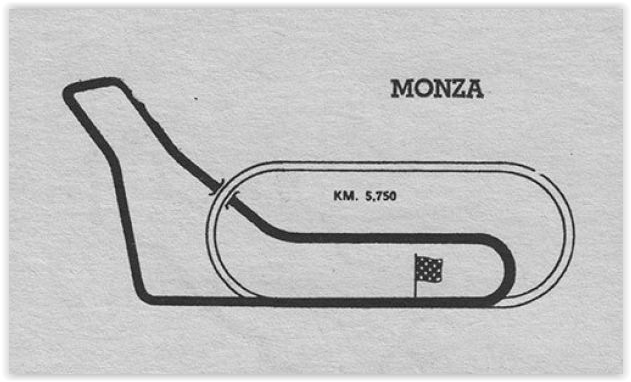
The smallest class at the Nations GP with a premiere
After Moto Morini and Benelli had already withdrawn from the factory for some time, a new manufacturer from Italy, Ducati, entered the rankings in this race. Around half a century later, this brand from the country with the shape of a boot would become the byword for sporty motorcycles. At the Grand Prix of Nations in Monza, however, the Bolognese brand was completely overshadowed by the greats from their country in the 1950s. These were primarily FB-Mondial, Gilera, Moto-Guzzi and MV Agusta. Therefore, in 1956 in the Royal Park of Monza in the smallest class up to 125cc, the attention was focused primarily on the three-way battle between MV, Mondial and the two-cylinder racer from Gilera, which was newly added that year. DKW also wanted to take part, but in contrast to the previous year, a dark shadow already hung over their factory operations. Due to the declining sales of what was still the world’s largest motorcycle manufacturer in the 1930s, there was a risk of Grand Prix racing being given up. Shortly before the war, the company, which was still producing in Zschopau (Saxony), was still the most successful brand in the European championship in the small to medium classes, especially in the 250s, before the World Cup was to take place in 1949.


The race for the little ones in Monza
The hoped-for three-way battle between MV, Mondial (both with their single-cylinder four-stroke engines) and Gilera on their new “Bicilindrica” two-cylinder machine soon became just a duel. The Solitude winner Romolo Ferri on the only factory Gilera had to give up in the thirteenth of 18 laps and because Sartori (FB-Mondial) and Taveri (MV Agusta) could no longer keep up early on, there was a tough duel between defending champion Carlo Ubbiali the fastest factory MV and compatriot Terquinio Provini on his Mondial. It became a head-to-head race that remained open until the last corner and kept the approximately 120,000 spectators in suspense. In the end, as so often this season, it was the “Chinese”, as many of his compatriots called him because of his narrow eyes, who narrowly came out on top. Sartorni on the second-best Mondial finished on the podium almost a minute behind, ahead of Taveri, Artusi with the new Desmo Ducati and Hofmann with what was possibly the last 125cc World Championship point for DKW in their racing history.

Favorite victory in the quarter liter Grand Prix of Monza
Despite considerable competition from home and abroad, Ubbiali was of course the top favorite here too. Having been declared world champion up to 250 cc for the first time, he naturally also wanted to shine in front of his home audience. With the veteran Enrico Lorenzetti on an improved Guzzi, as well as the two MV factory team colleagues Taveri and Venturi, the toughest opponents emerged early after the start. However, the Swiss with Italian roots was once again unable to keep up with the pace at the front this season. Towards the end, as with the 125s, it was Carlo Ubbiali again who, from the penultimate lap onwards, easily pulled away from Lorenzetti as his most pressing pursuer in order to also win the second race, for which he had registered. Venturi followed a respectable distance behind the runner-up and thus completed the podium. Taveri took the mostly thankless fourth place ahead of the fourth best Italian Montanari, behind him 4 private NSU Sport-Max 250 machines, with Sammy Miller as the fastest in the last points position.



Surprise winner up to 350cc in the royal park of Monza
Actually, everyone had expected a duel between MV and Guzzi, in which DKW and Gilera were only given a supporting role. But the brand with its superstar Geoff Duke, which had dominated the premier class for years, had now launched a very powerful weapon for the 350cc class. But it wasn’t the first time the Englishman had bad luck in what had been a difficult season for him and had to park his new gem with a defective clutch. But now it’s better to start from the beginning. With a total of 4 factory riders, Guzzi had the largest delegation, led by the new two-time world champion Bill Lomas, plus Kavanagh, Dale and Campbell. Without Surtees, who is still sidelined with an injury, MV relied on Masetti and Colombo. The Gilera factory team competed with Duke and Liberati, as well as DKW with Hobl, Hofmann, Sandford and Bartl. As is so often the case, the two-stroke engines had the advantage again at the push start and yet it was soon Liberati who was dictating the pace at the front in front of the Guzzis. The DKW drivers lacked top speed, which is why they lost a lot of ground early on. While in second position, Lomas overdone it and flew off in the Lesmo corner, which is why he had to miss the start with the V8 machine in the premier class due to an arm injury. Duke had already retired on lap 3 and behind Dale in P2 Colombo took the final podium place. DKW consoled themselves for the weekend with places 4 to 7 for their four factory drivers, with only Bartl outside the points.

Salvation for Duke in the 500 class
Having remained winless until then, the race in the premier class finally brought relief for last year’s world 500cc champion, who had already won 6 titles in the largest two categories. But Geoff Duke had a tough job to do before he passed the checkered flag in relief. Without Surtees, this race became a true Gilera Festival. While Campbell’s machine didn’t start, he had to chase after the field, a minute behind. Liberati led from the start ahead of his Gilera colleagues Monneret and Duke, followed by Milani, Zeller and Bandirola. On lap 4, Duke was in P2 behind the leader after a new record lap and Campbell had to abandon his machine and retire after an impressive race to catch up. Milani grabbed Zeller, who later caught the Italian again and soon four Gileras were in the lead. Duke slowly began to get serious and put Liberati under more and more pressure, but missed the Parabolica with 12 laps to go and had to go through the emergency exit, but was able to resume the pursuit of the leader in front of Monneret, Armstrong, Bandirola and Zeller. He actually caught up with the local hero and passed him in the Parabolica. The lead changed again, but in the end the Englishman was a hair’s breadth ahead in a photo finish and thus took his first and only win of the 1956 season.


The death knell for a real international fight
What had been apparent since 1955, when the English factories only took part in the national rounds of the World Championship, led to the final end at the end of the 1956 season. AJS and Norton officially announced that they would be completely withdrawing from the factory next season. Because a year before, NSU had already surprisingly exited as the dominant manufacturer in the smaller categories for two years, this was tantamount to a collapse. You can see in our Part 1 of the 1957 season how much the list of official factory teams had shrunk afterwards. With the exception of BMW’s initially half-hearted participation, the Italian brands were now expected to be almost entirely on their own and their ranks were also expected to thin out dramatically within a year. In terms of sports politics, the 1956 season basically sounded the death knell for motorcycle racing in the golden 1950s due to the suspension of Geoff Duke and the thinning out of the factory teams.



Various and unfortunately mostly very sad news at the end of the year
On the one hand, DKW’s factory withdrawal finally marked the end of the golden 1950s in German racing and, on the other hand, a particularly tragic report made the rounds in November 1956. Only two years after his retirement as an active racing driver, he had a fatal accident on November 13, 1956 during a test flight while practicing his new hobby, flying. He had achieved 14 Grand Prix victories by 1954 and triumphed 16 times at the German Championships before he said goodbye to racing after the fatal accident involving his friend and NSU factory team colleague. Of course, he was particularly shocked by this and, at a time when at least 10 to 15 pilots lost their lives in two-wheel racing every year, this was completely understandable.

The reasons for Haas’ resignation
The Augsburg native started off-road racing together with his brother Otto in 1955, apparently also to fulfill his contract with NSU. Dark stories about disqualifications led him to give up all competitions in July 56 to devote himself to his gas station in Augsburg and his new passion, aviation. It is possible that his resignation as their figurehead also had a significant influence on NSU’s factory withdrawal, but we will never know for sure. It was only by chance, or rather bad luck with injuries to two of the Neckarsulm company’s factory drivers, that he was chosen as a replacement for the first German GP at Solitude in 1952 on the evening before the race. He immediately won his home race, which ultimately became the foundation for an incredible career for the likeable Swabian. Shortly after Hans Baltisberger, the third of the four NSU Musketeers from 1954 died and only old master H.P. Müller survived. For more about the four musketeers of the most successful German manufacturer in the world championship, see our page under “History – Drivers”.
We summarized the 1956 season in numbers






Our summary of the many fatalities in road racing in 1956



Unless otherwise stated, this applies to all images (© MotoGP).
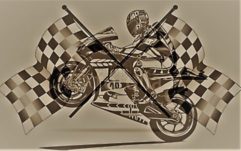
No Comments Yet